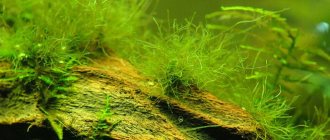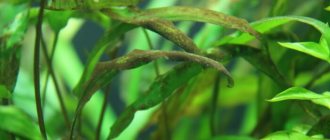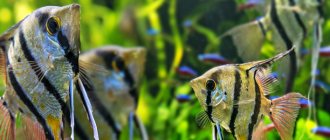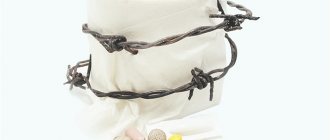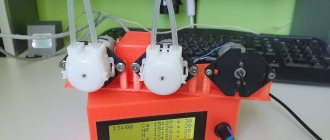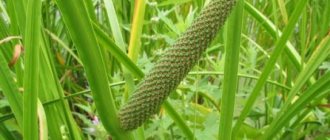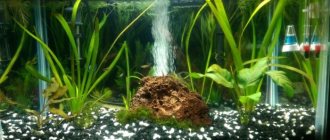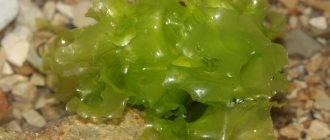The use of hydrogen peroxide in an aquarium according to dosages is acceptable. Peroxide is used against algae, water cloudiness and disease.
Nowadays, every aquarist has different water tests, conditioners, fish medicines, etc. But no one knows about hydrogen peroxide, which costs a penny at the pharmacy. And that peroxide can replace expensive products sold in specialized stores. Let's take a closer look at why hydrogen peroxide is needed in an aquarium.
How it works
Hydrogen peroxide is characterized by the presence of pronounced disinfectant and antiseptic properties. When adding peroxide to the aquatic environment of the aquarium:
- Destroys bacteria, pathogens and some types of organic matter that are harmful to ornamental fish.
- Enriches the aquatic environment with oxygen due to its ability to almost instantly split into hydrogen and oxygen upon contact with water.
- Destroys overgrown algae.
- Effectively fights a number of bacterial, infectious and parasitic diseases affecting aquarium inhabitants.
- Helps prevent further spread of infection in the aquatic environment and infection of other fish when one or more individuals become ill.
Terms of use . It is very important to use the product correctly, first diluting it in water. The use of hydrogen peroxide in its pure form can cause severe burn injuries to fish and leaves of green spaces.
After 30-60 minutes from the moment of adding peroxide to the aquarium, it is necessary to replace the water by at least 30-50% of the total volume of liquid in the tank, and also siphon the soil. Otherwise, there is a possibility of the formation of dead organic matter, which provokes the development of putrefactive processes.
The use of peroxide in the treatment of aquarium inhabitants
Cross hydrogen can be used to treat aquarium fish:
- infectious processes affecting fins;
- fin rot;
- parasitic diseases;
- gill rot;
- Columnaria;
- saprolegniosis;
- false neon disease.
The product will also help to resuscitate ornamental fish with asphyxia caused by acidified water, increased levels of carbon dioxide or ammonia in the aquatic environment.
Dosages. For fin rot, infections, and parasitic diseases, the solution is added to the aquarium at the rate of 3 ml of product per 10 liters of water. Thus, it is possible to quickly fill the aquatic environment with oxygen and reduce the concentration of ammonia.
When treating other diseases, peroxide is added to an artificial reservoir in a dosage of about 2-2.5 ml per 10 liters of liquid. This procedure should be carried out 2 times during the day. The optimal duration of the therapeutic course is 1-2 weeks.
Another treatment option is baths with hydrogen peroxide. To do this, add peroxide in a 1:1 ratio to a separate tank filled with clean water and place the sick individual in it for no more than 5 minutes.
Symptoms
Semolina in aquarium fish is manifested by the appearance of white dots on the surface of the body, as in the photo. The behavior of pets also changes. After the parasite penetrates the epithelium, itching, pain, and general weakness appear. This is what influences behavior.
Pets become shy, refuse food, tuck their fins, swim little or try to scratch themselves on the ground, shells or stones. After detection of ichthyophores, it is necessary to begin treatment of the disease as early as possible.
Yandex pictures
Getting rid of algae
Hydrogen peroxide quickly and effectively combats:
- single-celled algae that cause water blooms;
- "black beard";
- blue-green algae, prone to accelerated growth.
Terms of use . The solution should be applied in a dosage of 2 to 2.5 ml per 10 liters of water. It is recommended to carry out the procedure daily for 1 week. To achieve maximum effect, it is better to apply peroxide using a disposable syringe without a needle so that the solution gets directly onto the algae.
The results of using peroxide become noticeable after 2-3 days of using this product.
Additional measures. Increasing the illumination and supply of carbon dioxide, normalizing the parameters of the aquatic environment, and reducing the levels of phosphates and nitrates present in an artificial reservoir will help enhance the effect of the therapeutic course.
Against black beard
Treatment with a disinfectant should be carried out in a common aquarium, having first separated the fish from the place where the peroxide will be poured using a suitable plate. The substance is used undiluted. 5 ml of the drug is taken into the syringe and, turning off the filter and compressor, carefully pour the product as close to the affected area as possible. The technique helps eliminate the problem at the stage of its occurrence. If the aquarium is 20 liters or less, it is necessary to pre-plant the fish.
Emergency measures
Emergency assistance with hydrogen peroxide may be required in situations where in an artificial reservoir there is a sharp excess in the amount of organic matter that poses a potential danger to aquarium inhabitants, aquatic and surface cultures.
Causes of increased organic compounds:
- Accidental release of a large amount of food into an artificial pond. For example, when a can of food is tipped over into an aquarium.
- Disabling filtration for several hours (due to technical problems, lack of electricity, etc.), since after turning on the device, an excessive amount of dead pathogens: viruses and bacteria are formed in the aquatic environment.
- Decomposition of dead large fish, the death of which was not detected in a timely manner by the aquarist.
In such situations, it is necessary to eliminate the factors that provoke pollution of the aquatic environment, increase aeration, replace the liquid in the aquarium by 30-40%, and then add a solution of hydrogen peroxide from 1 to 2.5 ml per 10 liters of liquid to the artificial reservoir.
Reanimation of a choking fish
During long transportation or a long stay in oxygen-poor water, the fish begins to suffocate. But don’t give up on it right away - try to revive it by adding hydrogen peroxide to the water at the rate of 40 ml of peroxide solution per 100 liters of water. Then you need to wait 20 minutes and if the condition of the fish improves, change 50% of the water and install a compressor, but if the condition of the fish remains unchanged, this fish cannot be saved. Please read the warnings at the end of this article carefully!
How do aquarium inhabitants tolerate hydrogen peroxide?
When optimal doses of hydrogen peroxide are added, most aquarium inhabitants tolerate it quite well.
Dosage standards. In order to avoid burn injuries and death of plant crops, it is important that the amount of peroxide does not exceed 2.5 ml per 10 liters of liquid. If we are talking about hard-leaved green spaces, then the dosage of the product can be increased to 5 ml of solution per 10 liters of liquid.
Peroxide is prohibited. Plants such as ludwigia, cabomba, vallisneria, and hornwort suffer from hydrogen peroxide intolerance. Therefore, if there are these crops in the aquarium, it is better to refuse to use peroxide, replacing it with a more gentle analogue, which can be purchased at a specialized store.
Who is allowed? Ornamental fish, shrimp, mollusks and snails tolerate peroxide well if the amount of solution does not exceed 5 ml per 10 liters of water. At the same time, it is important that when applying the product, it under no circumstances gets on the pet’s body, since this is fraught with severe burn injuries and dangerous consequences, including death.
Treatment of external bacterial infections of fish
As you know, most pathogenic microorganisms cannot tolerate high levels of oxygen in water. That is why the annotations for various antibacterial drugs (and not only for them) indicate that the water in the quarantine tank should be well aerated). However, even without the use of drugs, ordinary peroxide can destroy some types of external bacterial infections (or significantly weaken the disease). Adding hydrogen peroxide to the water at the rate of 25 ml per 100 liters of water when added daily (or when added twice a day) will help the fish for 7-14 days.
Carrying out disinfection
Hydrogen peroxide is an excellent means for disinfecting an artificial reservoir, as it quickly and effectively destroys pathogenic microflora.
It is recommended to carry out disinfection in case of excessively active reproduction of snails, algae growth, as well as after infectious diseases suffered by aquarium inhabitants.
Rules for disinfection:
- During the procedure, fish, plants, shellfish, and shrimp should be moved to another tank with clean water.
- Pour a concentrated solution of hydrogen peroxide about 40% into the aquarium and dilute with water so as to achieve a concentration of 4-6%.
- Wearing protective gloves on your hands, treat the walls of the tank, soil, and decorative elements present in the aquarium with the product.
- At the end of the procedure, the tank must be thoroughly rinsed with plenty of clean water and the soil must be siphoned.
- An artificial pond can be filled with liquid and aquarium inhabitants can be placed back into it.
When else is hydrogen peroxide used?
In addition to treatment, disinfection and algae control, aquarists use hydrogen peroxide in a number of other cases:
- Oxygen saturation . Enriching the aquatic environment with oxygen is important during the spawning period and for the accelerated, full development of fry, especially in the absence of a sufficient amount of green space in the spawning area.
- Incubation of Artemia eggs . For this purpose, before placing them in a special incubator, the eggs are completely filled with a solution of hydrogen peroxide for 30-40 minutes.
- Prevention . For example, if the operation of compressors and aerators malfunctions, or if the aquarium is overcrowded. In this case, peroxide will increase oxygen levels in the aquatic environment, which is important for maintaining the healthy state of ornamental fish and other aquarium inhabitants.
Hydrogen peroxide is an effective remedy that should always be on hand for the aquarist.
But this solution cannot be called absolutely safe for both green spaces and aquarium inhabitants.
Therefore, experts recommend using peroxide only in emergency cases, strictly observing the optimal dosage. Hydrogen peroxide is not suitable for constant maintenance of an artificial pond.
Fighting Hydras
Hydra is a real scourge for the aquarist: with its tentacles equipped with stinging cells, it leaves burns on the body of the fish, and damaged tissue of the fish can become a source of infection, and hydra in an aquarium with small fry is a potential death for the latter! Methods of combating hydra, such as illuminating one surface and then mechanically collecting the hydras that have accumulated on it, are not effective. Hydrogen peroxide will help kill all the hydras in the aquarium in just half an hour. 40 ml of peroxide per 100 liters of water is the formula for completely getting rid of these unwanted invaders. Please read the warnings at the end of this article carefully!
